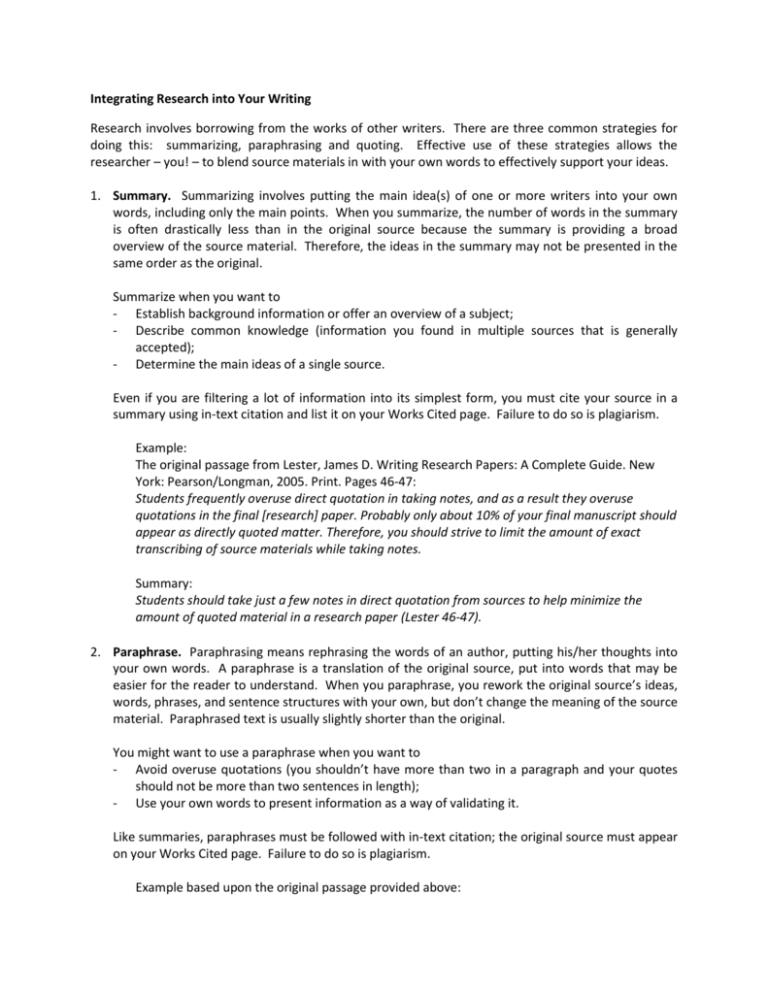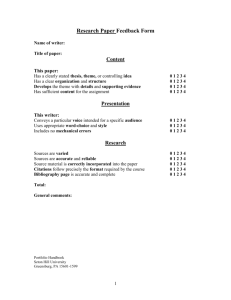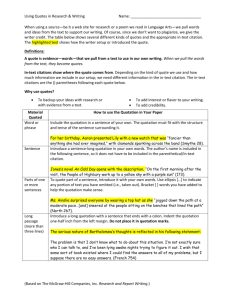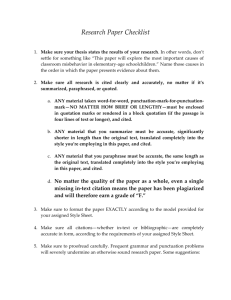
Integrating Research into Your Writing
Research involves borrowing from the works of other writers. There are three common strategies for
doing this: summarizing, paraphrasing and quoting. Effective use of these strategies allows the
researcher – you! – to blend source materials in with your own words to effectively support your ideas.
1. Summary. Summarizing involves putting the main idea(s) of one or more writers into your own
words, including only the main points. When you summarize, the number of words in the summary
is often drastically less than in the original source because the summary is providing a broad
overview of the source material. Therefore, the ideas in the summary may not be presented in the
same order as the original.
Summarize when you want to
- Establish background information or offer an overview of a subject;
- Describe common knowledge (information you found in multiple sources that is generally
accepted);
- Determine the main ideas of a single source.
Even if you are filtering a lot of information into its simplest form, you must cite your source in a
summary using in-text citation and list it on your Works Cited page. Failure to do so is plagiarism.
Example:
The original passage from Lester, James D. Writing Research Papers: A Complete Guide. New
York: Pearson/Longman, 2005. Print. Pages 46-47:
Students frequently overuse direct quotation in taking notes, and as a result they overuse
quotations in the final [research] paper. Probably only about 10% of your final manuscript should
appear as directly quoted matter. Therefore, you should strive to limit the amount of exact
transcribing of source materials while taking notes.
Summary:
Students should take just a few notes in direct quotation from sources to help minimize the
amount of quoted material in a research paper (Lester 46-47).
2. Paraphrase. Paraphrasing means rephrasing the words of an author, putting his/her thoughts into
your own words. A paraphrase is a translation of the original source, put into words that may be
easier for the reader to understand. When you paraphrase, you rework the original source’s ideas,
words, phrases, and sentence structures with your own, but don’t change the meaning of the source
material. Paraphrased text is usually slightly shorter than the original.
You might want to use a paraphrase when you want to
- Avoid overuse quotations (you shouldn’t have more than two in a paragraph and your quotes
should not be more than two sentences in length);
- Use your own words to present information as a way of validating it.
Like summaries, paraphrases must be followed with in-text citation; the original source must appear
on your Works Cited page. Failure to do so is plagiarism.
Example based upon the original passage provided above:
In research papers students often quote excessively, failing to keep quoted material down to a
desirable level. Since the problem usually originates during note taking, it is essential to minimize
the material recorded verbatim (Lester 46-47).
Why is this paraphrase actually an example of plagiarism?
Original:
Students frequently overuse direct quotation in taking notes, and as a result they overuse
quotations in the final [research] paper. Probably only about 10% of your final manuscript should
appear as directly quoted matter. Therefore, you should strive to limit the amount of exact
transcribing of source materials while taking notes.
Paraphrase/plagiarism:
Students often use too many direct quotations when they take notes, resulting in too many of
them in the final research paper. In fact, probably only about 10% of the final copy should consist
of directly quoted material. So it is important to limit the amount of source material copied while
taking notes.
3. Direct Quotation. Quotations are the exact words for an author, copied directly from the source
word for word.
Limit your use of direct quotations to two a paragraph with no more than two sentences in each
quote. Use quotations when you
- Want to add the power of an author’s words to support your argument;
- Want to disagree with an author’s argument;
- Want to highlight a particularly well-said or powerful phrase;
- Are comparing and/or contrasting specific points for view;
- Want to note the important research that preceded your own.
The words you quote must be placed in quotation marks and followed by an in-text citation. In
practice that means that you state the writer’s name (full name for first reference or last name only
for subsequent references) as the quote begins. Be sure to include the page number of your source
at the end of the quote.
Example:
Students frequently overuse direct quotation in taking notes, and as a result they overuse
quotations in the final [research] paper. Probably only about 10% of your final manuscript should
appear as directly quoted matter. Therefore, you should strive to limit the amount of exact
transcribing of source materials while taking notes (Lester 46-47).
You can use a partial quotation, but note that material has been omitted by using ellipsis points.
You can also begin the quotation at any point in the quote as long as the quote’s meaning is not
altered.
Example:
The German people had no reason for hope and researcher Friedrich notes “a kind of madness
swept the country. . . . The Wall Street Crash of 1929 started a worldwide depression to which
the shaky German economy was especially vulnerable” (41).
Don’t assume that a quotation is self-explanatory. Always include your own words that interpret
the quote to clarify what you want readers to understand from it.
4. Combined Quotation and Paraphrase. You might want to paraphrase a part of the idea, but also
use the exact words of the author. Just be sure to use quotation marks around those words that are
taken directly from the original source.
Example:
At schools working with E.D. Hirsh’s Core Knowledge Foundation, “teaching cultural knowledge is
indistinguishable” from the basics of reading, writing and arithmetic that our grandparents
learned (Toch 60).
In-Text Citations
The basic rule when writing in-text citations is to make the research as much a natural part of the
sentence as you can. Quotations should be integrated into your own sentences. Don’t drop quotes into
your text without warning and avoid standing quotes alone as sentences. Instead provide clear signal
phrases, which include the author’s name, to prepare the readers for the quotation.
Examples:
Although the bald eagle is still listed as endangered, the species has recovered numbers.
According to ornithologist Jay Sheppard, "The bald eagle seems to have stabilized its population,
at the very least, almost everywhere" (96).
In the words of author and activist Rick Bass, "…
As Flora Davis has noted, "…
The Gardners, experts in Colorado Plateau archaeology, point out that "…
When you choose to use a direct quote, remember that the words you take from your research source
must be placed in quotation marks. One common technique is to identify the research source at the
beginning of the sentence followed by the part of quote that is most important to your point.
Example:
Diane Vaughan cites a shuttle engineer who says NASA was “absolutely relentless and
Machiavellian” about following procedures to the letter (221).
When your own sentence mentions the author, do not repeat the author in the parenthetical citation.
Use only the page number in parenthesis with the period at the end of the sentence and outside the
final parentheses.
You can use the same short quote as part of the larger sentence without identifying the source. In this
case, the in-text citation must include both the author’s last name and the page number. The period
goes outside the final parentheses.
Example:
One engineer who figures prominently in all accounts of the 1986 Challenger accident says NASA
was “absolutely relentless and Machiavellian” about following procedures to the letter (Vaughan
221).
When you include a summary or paraphrase in your paragraph, you do not need quotation marks but
you do need to note your source. Add the author’s last name and page number at the end of the
sentence in parenthesis with the period outside the final parentheses.
Example:
One critic contends that the story is a tale of feminism gone wrong (Alberts 234).
If the source you are citing in your in-text citation doesn’t have an author or page number, as is
sometimes the case when referencing a website, use the name of the article instead of the author’s last
name and/or the abbreviation n.p. to indicate that there is no page provided. The period at the end of
the sentence goes outside the final parentheses.
Example:
A recent newspaper article demonstrated just how thoroughly the neighborhood's gruesome
past has been forgotten by its residents (Jackson n.p.).
Creating a Works Cited Page
Your Works Cited page is a list of all the sources you have cited in any in-text citation. The easiest way
to create your citations is to use a web-based citation creator such as EasyBib.com or
CitationMachine.net. These tools can create the citation in its correct format (for this paper, use MLA)
only IF you provide the accurate information. While some reliable sources don’t provide all the
information EasyBib and CitationMachine ask for, you should be leery of using a resource that doesn’t
provide most of this data.
MLA Works Cited Format Guidelines
1.
2.
3.
4.
Double space all entries!
Organize in alphabetical order, beginning for the first term in each entry.
If an item in an entry is not provided, skip it and use the next available piece of information.
If an entry takes more than one line, indent all subsequent line.
Works Cited – Centered
Format for a Book:
Last Name, First Name. Book Title. City: Publisher, Date.
Bradley, Marion Zimmer. The Mists of Avalon. New York: The Random House Publishing Group, 1982.
Format for a Magazine:
Last Name, First Name. “Article Title.” Magazine Publication Day Month Year: Pages.
Matthews, Owen. “New Model Army.” Newsweek 8 September 2008: 64-65.
Format for a Newspaper:
Last Name, First Name. “Article Title.” Newspaper Title Publication Day Month Year, Sec.:Page.
Healey, James R. “Want better mileage? It’s going to cost you.” USA Today 3 September 2008, B1.
Format for a Web Page:
Last Name, First Name. "Article Title." Site Title. Date posted or last updated. Sponsor. Access Day
Month Year <http://address>.
Ridley, John. “Your Pocket Guide to Palinguage.” NPR. 3 September 2008. National Public Radio. 4
September 2008
<http://www.npr.org/blogs/visibleman/2008/09/your_pocket_guide_to_speaking_1.html>.
Format for Internet Journal or Magazine:
Last Name, First Name. "Article Title." Publication Title. Vol. Publication Day Month Year. Pages. Access
Day Month Year <http://address>.
Frey, Nancy and Douglas Fisher. “Doing the Right Thing with Technology.” English Journal. Vol. 97. July
2008. 3 September 2008 <http://www.ncte.org/pubs/journals/ej/articles/130014.htm>.
Format for Resource found through EBSCOhost:
Last Name, First Name. “Article Title.” Publication Title. Vol. (Publication Day Month Year): Pages.
Database Name. EBSCOhost. Northwood High School Library. Access Day Month Year
<http://address>.
Halliday, Jean. “Prius Prices Outrun Inventory.” Advertising Age. Vol. 79 (4 August 2008): 3-25. MAS Ultra
– School Edition. EBSCOhost. Northwood High School Library. 4 September 2008
<http://search.ebscohost.com/login.aspx?direct=true&db=ulh&AN=33538486&site=src-live>.
Sample Works Cited
"Birth Order." Child Development Institute. 2007. Child Development Institute, LLC. 25 Oct 2007
<http://www.childdevelopmentinfo.com/development/birth_order.htm>.
Bradley, Marion Zimmer and Diana L. Paxson. Priestess of Avalon. New York: RoC, 2002.
Conroy, Frank. “A Yo-Yo Going Down.” A Writer’s Reader. Ed. Donald Hall and D. L.Emblen. Boston:
Little, Brown and Company, 1982.
Cowley, Geoffrey and Karen Springen. “First Born, Later Born.” Newsweek. Vol. 128. 7 October 1996:
68-84. Vocational and Career Collection. EBSCOhost. Northwood High School Library. 24 October
2007 <http://www.ebscohost.com>.
Guastello, Denise D and Stephen J. Guastello. "Birth Category Effects on the Gordon Personal Profile
Variables." JASNH Vol. 131. May 2002. 1-7. 24 October 2007 <http://www.jasnh.com/a1.htm>.
Kluger, Jeffrey. “The Power of Birth Order.” Time 29 October 2007: 42-48.
Peres, Judy. “’Morning-after pill deal reached: Pharmacists, state accept rule change.” Chicago Tribune.
11 October 2007, A4.







